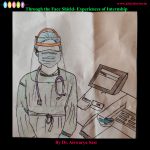The retrospect-o-scope is one of the finest instruments of knowledge. We understand that each developing civilization evolved its own perspective on Health and Disease. The cross-currents across these human settlements being few and far between, healing expressed itself as localized approaches isolated in their repertories that addressed local problems tackled with local resources.
The simplest were “remedies” drawn from the knowledge of the shepherd and the largely unrecognized “home” bank, the chief possessor, implementer and propagator of such treasure being the woman, usually the mother. The grandmother is the wiser version of this trove, with the needed checks, balances, validation and such stuff. It is even so till date.“Therapies” derived from them were prolonged and involved, requiring more experience and understanding of the human organism and responses to disease and interventions employed. The ingredients for such interventions were mainly plant and animal (also mineral, where the other two were scarce, or this resource in abundance) with different modes of processing and differing effects being taken into account. The same stuff was given raw, crushed, dried, roasted, boiled, fried, pickled and so on – good research indeed.
The philosophers and religious enter the picture now and adopt (is it co-opt?) these “peoples’ practices” into their world view. The intellectual domination begins, with a framework laid down to explain the how, why, which of what’s observed and the grounds for further development – the cons and pros (so to say) of the evolutionary path taken. The rituals, taboos, dos and don’ts get incorporated and have their say in the matter.
The simple, subjective understanding of “hot” and “cold” is characteristic of explanations involving home, herbal and tribal remedies. What happens when you (manage to) consume six eggs in one meal – that’s hot (specific dynamic action of protein in current lingo)!! Why avoid buttermilk after getting drenched in the rain, while it is the recommended drink when you come in from the sun during summer? Yes, you got it – it’s cold. These are sort of everyone’s experience and easily validated by common understanding – objective, in a subjective way. It’s the elite cited earlier who made it more cerebral and therefore abstract to the commoner. In a way, the professional and his client are equally foxed. What do you tell the patient who asks about what hot foods to avoid when he is taking the prescribed antibiotics, since such medicine increases the heat in his system!
The Chinese system of Acupuncture uses the concept of Yin and Yang to explain how it works. Ayurveda, Siddha Yoga and Naturopathy (the systems of Indian origin) explain their philosophies on the basis of the interactions of the triad of Vaata, Pittha and Kapha. Unani-Tibb (remember Hippocrates being the father of this system from Greece?) explains health, disease and life on the quadruple concept of four Humors, named after colors as the Yellow, Green, Red and Black humors. These theories extend their reach into all aspects of life, such that food, seasons, constitutions, behavior, activities – in general, all and sundry – are classified as one type or the other, depending on the “system-lens” one adopts.
The concept of BALANCE and HARMONY is common to all these systems, between the dyad, triad or more components in their philosophies – signifying health. Imbalance on the other hand means ill-health and is rectified or brought back to balance and harmony using all possible resources in a person’s life, which have also been classified using the same system. It makes sense only if one knows the system and classification criteria. That is what students of these systems are to study in their courses for graduation. They are made to learn human Anatomy, Physiology, Biochemistry, Pathology and Community Health of Modern medicine before they explore their own systems in the time left. Ponder over the effects of this policy.
An organic connection from their origins and the localized nature of development of therapies led to easy incorporation into peoples’ daily life. “Lifestyle” in terms of diet, work, rest, recreation etc., got organized towards health. Disease was still a visitation from the unknown, though amenable to managing with modification of lifestyle and some simple medication. It remains so, even today! This internalization of health-promoting practices was no doubt eminently facilitated by religious dogma and a fear of the unknown.
Spices are difficult to cultivate and grow, since their requirements are stringent. Yet, these have been so well incorporated into the Indian diet, that no dish/meal is complete without them. The “Sambar” and “Rasam” in a south Indian meal is an exemplary kashayam (decoction) of spices that enhance the functions of the Digestive, Respiratory, Skin, Uro-genital and Musculo-skeletal systems, and maintain their state of health. The ginger, pepper, turmeric, tamarind, mustard, fenugreek, cumin seeds etc., are also components of other medicinal preparations for their actions. The proportions of these vary with seasons, regions and cultures, only for health reasons. This incorporation of health promoting practices into the fabric of human life is the acme of preventive and promotive health care. Is it any wonder that Europeans braved the seas and scurvy to access these spices from the east?
The point here is not to glorify the past. It is to underline the essence of medicine’s role in promoting health in the human being that seems to have been the direction the alternatives pursued. It is recorded that the Chinese village doctor was paid a regular sum by people who were healthy. He paid them their wage losses in addition to treating them at his own cost when they fell sick. The Indian doctor was mostly supported by the state (king) to enable complete devotion to the profession and be free from problems of survival/livelihood.
Health nowadays is a Corporate Social Responsibility – Doctor, where are you? Ponder.











